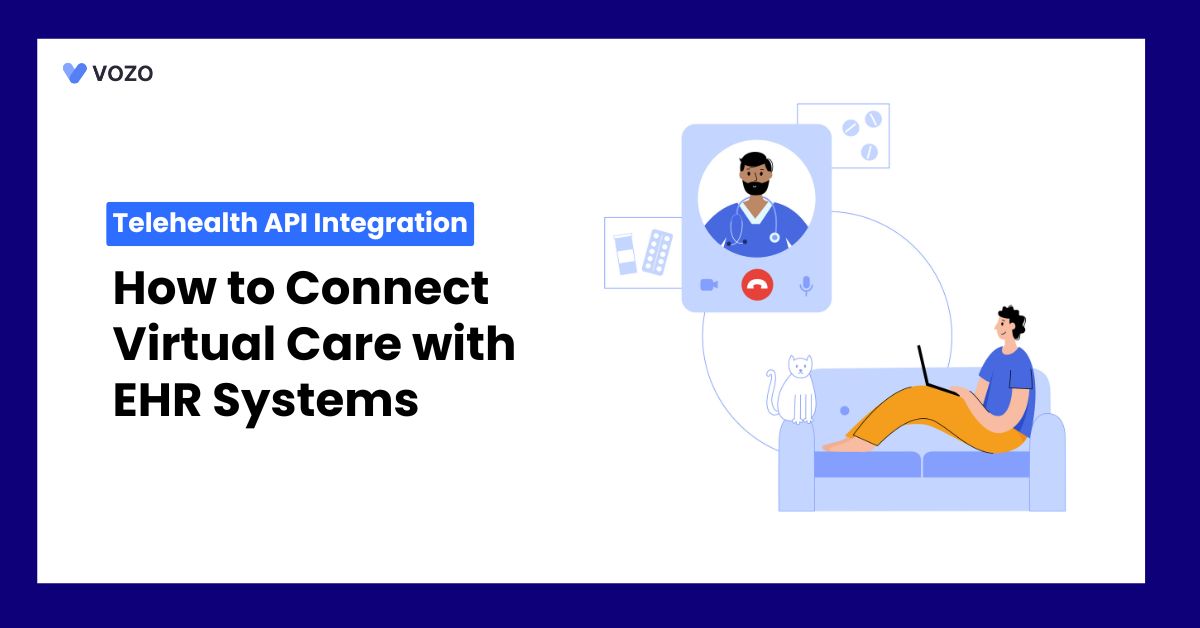Telehealth API Integration: How to Connect Virtual Care with EHR Systems
The global telehealth market is expected to reach over USD 55 billion by 2025. Telehealth integration with EHR systems has increased by the factors of the COVID-19 pandemic and the need for accessible healthcare. This led to streamlined workflows and enhanced patient care.
Through telehealth API integration, virtual visits are simplified. Integrating telehealth into EHR systems allows for a seamless experience and securely stores patient data.
In this blog, we’ll explore the benefits of Telehealth API Integration and how it connects virtual care.
What is Telehealth API Integration
Telehealth API integration is a process of connecting APIs with EHR systems. APIs provide a secure, real-time connection between telehealth platforms and existing EHR systems.
The combination of EHR systems and telehealth technology allows for smooth data sharing and communication between healthcare providers and patients during virtual consultations.
Benefits of Telehealth Integration with EHR System
1. Access to Real-time Data
Telehealth integrated with an EHR system allows providers immediate access to complete patient data. This includes medical history, lab results for a more detailed diagnosis, and treatment plans.
2. Communication & Care Coordination
Secure communication channels are secure between patients and providers for easy access to consultations, follow-ups, and queries through the patient portal. Patients don’t need to repeat the information, while providers will have complete data during virtual visits.
Better care coordination and collaboration between primary care providers, specialists, and other healthcare providers.
3. Improved Patient Engagement
Telehealth Integration with EHR systems improves patient engagement without in-person visits through a detailed patient-centric approach. This helps patients in their healthcare journey.
4. Reduced Administrative Burden
Telehealth Integration reduces data entry and manual record updates. Data entry processes, appointment scheduling, and documentation reduce paperwork and administrative tasks, leading to cost savings and increased efficiency.
5. Data Exchange
Integration facilitates seamless data exchange for proactive care and significantly contributes to better patient outcomes. It helps in timely intervention, which helps monitor patient health, adjust treatment plans accordingly.
Related: 5 Ways Vozo Telehealth Makes Virtual Health Consultation Better
Steps to Connect Virtual Care with EHR System Using Telehealth Integration
Here are the steps to integrate telehealth with the EHR System
1. Planning & Assessment
Identify the integration goals, purpose, whether it’s appointment management, virtual consultation documentation, or automated data sync.
Assess your existing system to check the compatibility with telehealth tools. This is one of the essential steps before integration.
2. Selection of Vendor
Select a vendor that provides services to both Telehealth and EHR systems in case you don’t have an EHR system. Conduct a thorough research based on compatibility, market, and reviews.
While selecting, consider the factors such as features, cost, customer support, security protocols, integration capabilities, and user reviews.
3. Security Standards
Standard integration is important for seamless data exchange in telehealth and EHR systems. Select a provider who offers HIPAA- GDPR compliant APIs with detailed documentation and support.
Common integration standards include HL7, FHIR. The right standards ensure security and compatibility for better communication between systems.
4. API Integration
Prepare the system for integration between Telehealth and EHR. Organize the data and check whether it is accurate, consistent during integration.
Data cleaning occurs and cleans the existing data, standardizing formats and ensuring data quality. Collaborate with the technical team to implement the integration of the API with the EHR system.
5. Testing & Validation
After the integration, test whether it is working properly, and check whether there are any issues in the system. Testing is important to ensure the integrity of the data.
Validate data through unit testing, user acceptance to ensure the system meets the quality standards.
6. Training & Support
Post integration, organisations must provide hands-on experience, support to users. Training will be helpful for users to know the benefits, user adoption, and reduce errors.
7. Continuous Monitoring
Post implementation, continuous monitoring and feedback are necessary to rectify the errors. Regular checks and maintenance are essential for the long-term success of EHR integration and regulatory compliance.
Related: 8 Ways to Utilize Advanced Analytics to Optimize Telehealth Services
Vozo Cloud EHR With Built-In Telehealth Platform
If you are searching for the best EHR system for your healthcare practice, Vozo EHR can be your go-to choice. Our comprehensive EHR solution lets you focus more on patient care while carrying all the burdens and simplifying them.
- Vozo Cloud EHR’s cost-effective cloud subscription benefits all levels of practice.
- Our feature-rich EHR helps you rectify mistakes efficiently and speed up the process.
- Vozo Specialty EHR resonates with specialty practice needs and requirements.
- Our expert technical team gets you covered 24/7 if any needs arise.
- Our EHR System continues to scale as your healthcare practice grows to improve the user experience.
The Vozo Customized EHR solution benefits your healthcare practice by:
- Streamlining the administrative process
- Improving workflow efficiency
- Reducing proneness to errors
- Manages all the patients’ records in one place
- Offers greater efficiency and cost savings across the board.
Our specialty-specific tools, like scheduling, patient portals, lab integration, cloud hosting, and more, meet the specific needs and requirements of your healthcare practice.
“Embrace Vozo EHR to Reduce Your Burdens and Enhance Patient Care”
About the author

With more than 4 years of experience in the dynamic healthcare technology landscape, Sid specializes in crafting compelling content on topics including EHR/EMR, patient portals, healthcare automation, remote patient monitoring, and health information exchange. His expertise lies in translating cutting-edge innovations and intricate topics into engaging narratives that resonate with diverse audiences.













